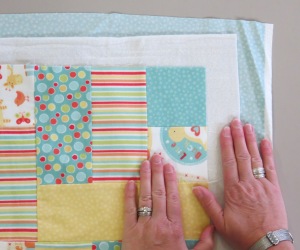Backing mysteries busted

With all of the time, money and effort that goes into creating a beautiful quilt top, you’d think that we would spend more time choosing the backing fabric! Sadly, by the time a quilt is finally put together, we’re often so anxious to get the quilt completed that we take some shortcuts when it comes to the backing fabric selection and preparation. Take these tips from our APQS team into consideration when choosing backing fabrics.
Think about thread colors you’d like to use in the quilt top, along with the batting you intend to use.
If your quilt top requires numerous thread color changes, you may be better off matching your top and bobbin thread colors to avoid seeing shadow-through from tension changes. That means that your backing fabric will have lots of different colors across its surface. Shop for a busy printed fabric that ties your quilt top together, and you’ll look very elegant as well as smart.
For darker backing fabric, study the fabric’s selvage edge before you buy it.
Look at the little pin dots along the selvage where the fabric was processed – can you see the lighter “wrong side” of the backing peeking up to the right side? When you use dark fabric as backing that has a very “light-colored” wrong side, it’s common for the larger longarm needles to “roll” the fibers in the backing. The larger needle rolls the individual strands of fabric outward, exposing the wrong side of the quilt on the right side!This phenomenon can look like you have bearding issues, but you won’t see the batting – you’re actually seeing the back side of the quilt!
Fiber content and thread count make a difference as well.
The tighter the weave of the fabric, the harder it will be to consistently balance tension in all directions. Increase your odds of success by using batting with some loft, such as a blended batting, wool or polyester.
Consider your thread thickness in conjunction with these factors. In theory, a thinner needle makes sense if the backing fabric is tightly woven. However, if the thread is thicker, or the batting is dense, you need a larger hole to be able to pull that thread through the layers.



